Site-Selective Incorporation of a Functional Group into Lys175 in the Vicinity of the Active Site of Chymotrypsin by Using Peptidyl α-Aminoalkylphosphonate Diphenyl Ester-Derivatives
Abstract
:1. Introduction
2. Results
2.1. Design of the Peptidyl Diphenylphosphonate Derivatives
2.2. Preparation of the Desired Csin Containing Dan Group at Lys175 (DanMCsin)
2.3. Characterization of DanMCsin
2.3.1. Fluorescent Property of DanMCsin
2.3.2. Identification of the Site Modified by DanE
2.3.3. Enzymatic Properties of DanMCsin
3. Discussion
4. Materials and Methods
4.1. General
4.2. Synthesis of the Chemical Modification Molecules DanD and DanE
4.2.1. Dan-β-Ala-Asp-Ala-Ala-(R)-PheP(OPh)2
4.2.2. Dan-β-Ala-Glu-Ala-Ala-(R)-PheP(OPh)2
4.3. Mass Spectrometry
4.4. Enzymatic Activity
4.5. Chemical Modification
4.6. Ion-Exchange and RP-HPLC Analyses
4.7. Inhibition by Bowman Birk Inhibitor
4.8. Fluorescence Analysis
5. Conclusions
Supplementary Materials
Author Contributions
Funding
Institutional Review Board Statement
Informed Consent Statement
Data Availability Statement
Acknowledgments
Conflicts of Interest
Sample Availability
References
- Oleksyszyn, J.; Powers, J.C. Amino Acid and Peptide Phosphonate Derivatives as Specific Inhibitors of Serine Peptidases. In Methods in Enzymology; Barrett, A.J., Ed.; Academic Press: San Diego, CA, USA, 1994; Volume 244, pp. 423–441. [Google Scholar] [CrossRef]
- Sieńczyk, M.; Oleksyszyn, J. Irreversible Inhibition of Serine Proteases by Peptide Derivatives of (α-Aminoalkyl)phosphonate Diphenyl Esters. Biochemistry 1991, 30, 485–493. [Google Scholar] [CrossRef]
- Oleksyszyn, J.; Boduszek, B.; Kam, C.; Powers, J.C. Novel Amidine-Containing Peptidyl Phosphonates as Irreversible Inhibitors for Blood Coagulation and Related Serine Proteases. J. Med. Chem. 1994, 37, 226–231. [Google Scholar] [CrossRef]
- Bertrand, J.A.; Oleksyszyn, J.; Kam, C.M.; Boduszek, B.; Presnell, S.; Plaskon, R.R.; Suddath, F.L.; Powers, J.C.; Williams, L.D. Inhibition of Trypsin and Thrombin by Amino(4-amidinophenyl)methanephosphonate Diphenyl Ester Derivatives: X-ray Structures and Molecular Models. Biochemistry 1996, 35, 3147–3155. [Google Scholar] [CrossRef]
- Jackson, D.S.; Fraser, S.A.; Ni, M.; Kam, M.; Winkler, U.; Johnson, D.A.; Froelich, C.J.; Hudig, D.; Powers, J.C. Synthesis and Evaluation of Diphenyl Phosphonate Esters as Inhibitors of the Trypsin-like Granzymes A and K and Mast Cell Tryptase. J. Med. Chem. 1998, 41, 2289–2301. [Google Scholar] [CrossRef]
- Sieńczyk, M.; Oleksyszyn, J. Irreversible Inhibition of Serine Proteases–Design and In Vivo Activity of Diaryl α-Aminophosphonate Derivatives. Curr. Med. Chem. 2009, 16, 1673–1687. [Google Scholar] [CrossRef] [PubMed]
- Maslanka, M.; Mucha, A. Recent Developments in Peptidyl Diaryl Phosphonates as Inhibitors and Activity-Based Probes for Serine Proteases. Pharmaceuticals 2019, 12, 86. [Google Scholar] [CrossRef] [Green Version]
- Woodard, S.L.; Jackson, D.S.; Abuelyaman, A.S.; Powers, J.C.; Winker, U.; Hudig, D.J. Chymase-Directed Serine Protease Inhibitor That Reacts with a Single 30-kDa Granzyme and Blocks NK-Mediated Cytotoxicity. J. Immunol. 1994, 153, 5016–5025. [Google Scholar] [CrossRef] [PubMed]
- Abuelyaman, A.S.; Hudig, D.; Woodard, S.L.; Powers, J.C. Fluorescent Derivatives of Diphenyl [-(N-Peptidylamino)alkyl]phosphonate Esters: Synthesis and Use in the Inhibition and Cellular Localization of Serine Proteases. Bioconjugate Chem. 1994, 5, 400–405. [Google Scholar] [CrossRef]
- Morty, R.E.; Troeberg, L.; Powers, J.C.; Ono, S.; Lonsdale-Eccles, J.D.; Coetzer, T.H.T. Characterization of Antitrypanosomal Activity of Peptidyl α-Aminoalkyl Phosphonate Diphenyl Esters. Biochem. Pharmacol. 2000, 60, 1497–1504. [Google Scholar] [CrossRef]
- Jakobsen, R.K.; Ono, S.; Powers, J.C.; DeLotto, R. Fluorescently Labeled Inhibitors Detect Localized Serine Protease activities in Drosophila Melanogaster Pole Cells, Embryos, and Ovarian Egg Chambers. Histochem. Cell. Biol. 2005, 123, 51–60. [Google Scholar] [CrossRef]
- Gilmore, B.F.; Carson, L.; McShane, L.L.; Quinn, D.; Coulter, W.A.; Walker, B. Synthesis, Kinetic Evaluation, and Utilization of a Biotinylated Dipeptide Proline Diphenyl Phosphonate for the Disclosure of Dipeptidyl Peptidase IV-like Serine Proteases. Biochem. Biophys Res. Commun. 2006, 347, 373–379. [Google Scholar] [CrossRef]
- Ono, S.; Murai, J.; Nakai, T.; Kuroda, H.; Horino, Y.; Yoshimura, T.; Oyama, H.; Umezaki, M. Site-selective Chemical Modification of Chymotrypsin Using a Peptidyl Diphenyl 1-Amino-2-phenylethylphosphonate Derivative. Chem. Lett. 2013, 42, 860–862. [Google Scholar] [CrossRef]
- Ono, S.; Nakai, T.; Kuroda, H.; Miyatake, R.; Horino, Y.; Abe, H.; Umezaki, M.; Oyama, H. Site-Selective Chemical Modification of Chymotrypsin Using Peptidyl Derivatives Bearing Optically Active Diphenyl 1-Amino-2-Phenylethylphosphonate: Stereochemical Effect of the Diphenyl Phosphonate Moiety. Biopolymers (Pep. Sci.) 2016, 106, 521–530. [Google Scholar] [CrossRef] [PubMed]
- Sletten, E.M.; Bertozzi, C.R. Bioorthogonal Chemistry: Fishing for Selectivity in a Sea of Functionality. Angew. Chem. Int. Ed. 2009, 48, 6974–6998. [Google Scholar] [CrossRef] [Green Version]
- Francis, M.B.; Carrico, I.S. New frontiers in protein bioconjugation. Curr. Opin. Chem. Biol. 2010, 14, 771–773. [Google Scholar] [CrossRef] [PubMed]
- Basle, E.; Joubert, N.; Pucheault, M. Protein Chemical Modification on Endogenous Amino Acids. Chem. Biol. 2010, 17, 213–227. [Google Scholar] [CrossRef]
- Spicer, C.D.; Davis, B.G. Selective Chemical Protein Modification. Nat. Commun. 2014, 5, 4740. [Google Scholar] [CrossRef] [Green Version]
- Wu, Y.W.; Goody, R.S. Probing Protein Function by Chemical Modification. J. Pept. Sci. 2010, 16, 514–523. [Google Scholar] [CrossRef] [PubMed]
- Shiraiwa, K.; Cheng, R.; Nonaka, H.; Tamura, T.; Hamachi, I. Chemical Tools for Endogenous Protein Labeling and Profiling. Cell Chem. Biol. 2020, 27, 970–985. [Google Scholar] [CrossRef]
- Sakamoto, S.; Hamachi, I. Recent Progress in Chemical Modification of Proteins. Anal. Sci. 2019, 35, 5–27. [Google Scholar] [CrossRef] [Green Version]
- Griffiths, R.C.; Smith, F.R.; Long, J.E.; Williams, H.E.L.; Layfield, R.; Mitchell, N.J. Site-Selective Modification of Peptides and Proteins via Interception of Free-Radical-Mediated Dechalcogenation. Angew. Chem. Int. Ed. 2020, 59, 23659–23667. [Google Scholar] [CrossRef]
- Maruyama, K.; Kanai, M. Synthetic Methodology-driven Chemical Protein Modification. Chem. Lett. 2019, 48, 1421–1432. [Google Scholar] [CrossRef] [Green Version]
- Thimaradka, V.; Oh, J.H.; Heroven, C.; Aricescu, A.R.; Yazaki, M.; Tamura, T.; Hamachi, I. Site-specific Covalent Labeling of His-Tag Fused Proteins with N-Acyl-N-alkyl Sulfonamide Reagent. Bioorg. Med. Chem. 2021, 30, 115947. [Google Scholar] [CrossRef]
- Sato, S.; Matsumura, M.; Kadonosono, T.; Abe, A.; Ueno, S.; Ueda, H.; Nakamura, H. Site-Selective Protein Chemical Modification of Exposed Tyrosine Resides Using Tyrosine Click Reaction. Bioconjug. Chem. 2020, 31, 1417–1424. [Google Scholar] [CrossRef] [PubMed]
- Neidhart, D.; Wei, Y.; Cassidy, C.; Lin, J.; Cleland, W.W.; Frey, P.A. Crystal Structure of Gamma Chymotrypsin with N-Acetyl-Phenylalanine Trifluoromethyl Ketone Bound at the Active Site. 2000. Available online: https://www.wwpdb.org/pdb?id=pdb_00001gg6 (accessed on 25 December 2022).
- Neidhart, D.; Wei, Y.; Cassidy, C.; Lin, J.; Cleland, W.W.; Frey, P.A. Correlation of Low-Barrier Hydrogen Bonding and Oxyanion Binding in Transition State Analogue Complexes of Chymotrypsin. Biochemistry 2001, 40, 2439–2447. [Google Scholar] [CrossRef] [PubMed]
- Johansson, E.; Tornoee, C.W. Alpha-Chymotrypsin from Bovine Pancreas in Complex with Bowman-Birk Inhibitor from Soybean. 2016. Available online: https://www.rcsb.org/structure/5j4q (accessed on 25 December 2022).
- Tornoee, C.W.; Johansson, E.; Wahlund, P.W. Divergent Protein Synthesis of Bowman-Birk Protease Inhibitors, their Hydrocynamic Behavior and Co-crystallization with α-Chymotrypsin. Synlett 2017, 28, 1901–1906. [Google Scholar] [CrossRef]
- Takaoka, Y.; Tsutsumi, N.; Kasagi, N.; Nakata, E.; Hamachi, I. One-Pot and Sequential Organic Chemistry on an Enzyme Surface to Tether a Fluorescent Probe at the Proximity of the Active Site Restoring Enzyme Activity. J. Am. Chem. Soc. 2006, 128, 3273–3280. [Google Scholar] [CrossRef]
- Tsukiji, S.; Miyagawa, M.; Takaoka, Y.; Tamura, T.; Hamachi, I. Ligand-Directed Tosyl Chemistry for Protein Labeling in vivo. Nat. Chem. Biol. 2009, 5, 341–343. [Google Scholar] [CrossRef] [PubMed]
- Fujishima, S.; Yasui, R.; Miki, T.; Ojida, A.; Hamachi, I. Ligand-Directed Acyl Imidazole Chemistry for Labeling of Membrane-Bound Proteins on Live Cells. J. Am. Chem. Soc. 2012, 134, 3961–3964. [Google Scholar] [CrossRef]
- Matsuo, K.; Nishikawa, Y.; Hashimoto, Y.; Sasaki, K.; Hamachi, I. Live-Cell Protein Sulfonylation Based on Proximity-driven N-Sulfonyl Pyridone Chemistry. Angew. Chem. Int. Ed. 2018, 57, 659–662. [Google Scholar] [CrossRef]
- Tamura, T.; Ueda, T.; Goto, T.; Tsukidate, T.; Shapira, Y.; Nishikawa, Y.; Fujisawa, A.; Hamachi, I. Rapid Labelling and Covalent Inhibition of Intracellular Native Proteins Using Ligand-Directed N-Acy-N-alkyl Sulfonamide. Nat. Commun. 2018, 9, 1870. [Google Scholar] [CrossRef] [PubMed] [Green Version]
- Tamura, T.; Tsukiji, S.; Hamachi, I. Native FKBP12 Engineering by Ligand-Directed Tosyl Chemistry: Labelling Properties and Application to Photo-Cross-Linking of Protein Complexes in Vitro and in Living Cells. J. Am. Chem. Soc. 2012, 134, 2216–2226. [Google Scholar] [CrossRef]
- Matsuo, T.; Imai, C.; Yoshida, T.; Saito, T.; Hayashi, T.; Hirota, S. Creation of an Artificial Metalloprotein with a Hoveyda-Grubbs Catalyst Moiety through the Intrinsic Inhibition Mechanism of α-Chymotrypsin. Chem. Commun. 2012, 48, 1662–1664. [Google Scholar] [CrossRef]
- Sano, Y.; Onoda, A.; Hayashi, T. A Hydrogenase Model System Based on the Sequence of Cytochrome C: Photochemical Hydrogen Evolution in Aqueous Media. Chem. Commun. 2011, 47, 8229–8231. [Google Scholar] [CrossRef] [PubMed]
- Onoda, A.; Fukumoto, K.; Arlt, M.; Bocola, M.; Schwaneberg, U.; Hayashi, T. A Rhodium Complex-Linked β-Barrel Protein as a Hybrid Biocatalyst for Phenylacetylene Polymerization. Chem. Commun. 2012, 48, 9756–9758. [Google Scholar] [CrossRef] [PubMed]
- Jared, C.L. Metallopeptide Catalysts and Artificial Metalloenzymes Containing Unnatural Amino Acids. Curr. Opin. Chem. Biol. 2015, 25, 27–35. [Google Scholar] [CrossRef] [Green Version]
- Onoda, A.; Hayashi, T. Artificial hydrogenase: Biomimetic Approaches Controlling Active Molecular Catalysts. Curr. Opin. Chem. Biol. 2015, 25, 133–140. [Google Scholar] [CrossRef]
- Oleksyszyn, J.; Subotkowska, L.; Mastalerz, P. Diphenyl 1-Aminoalkanephosphonates. Synthesis 1979, 1979, 985–986. [Google Scholar] [CrossRef]
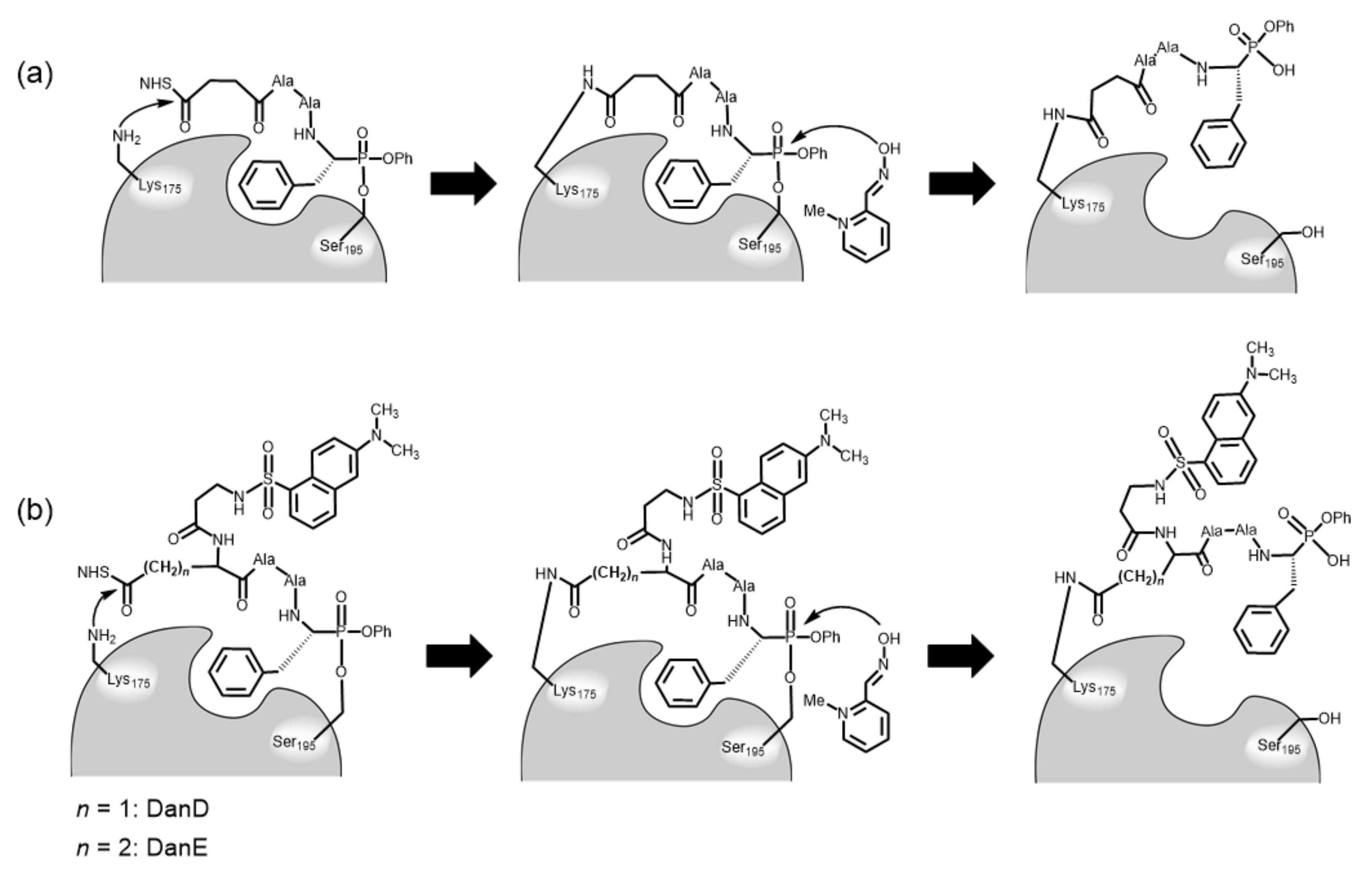
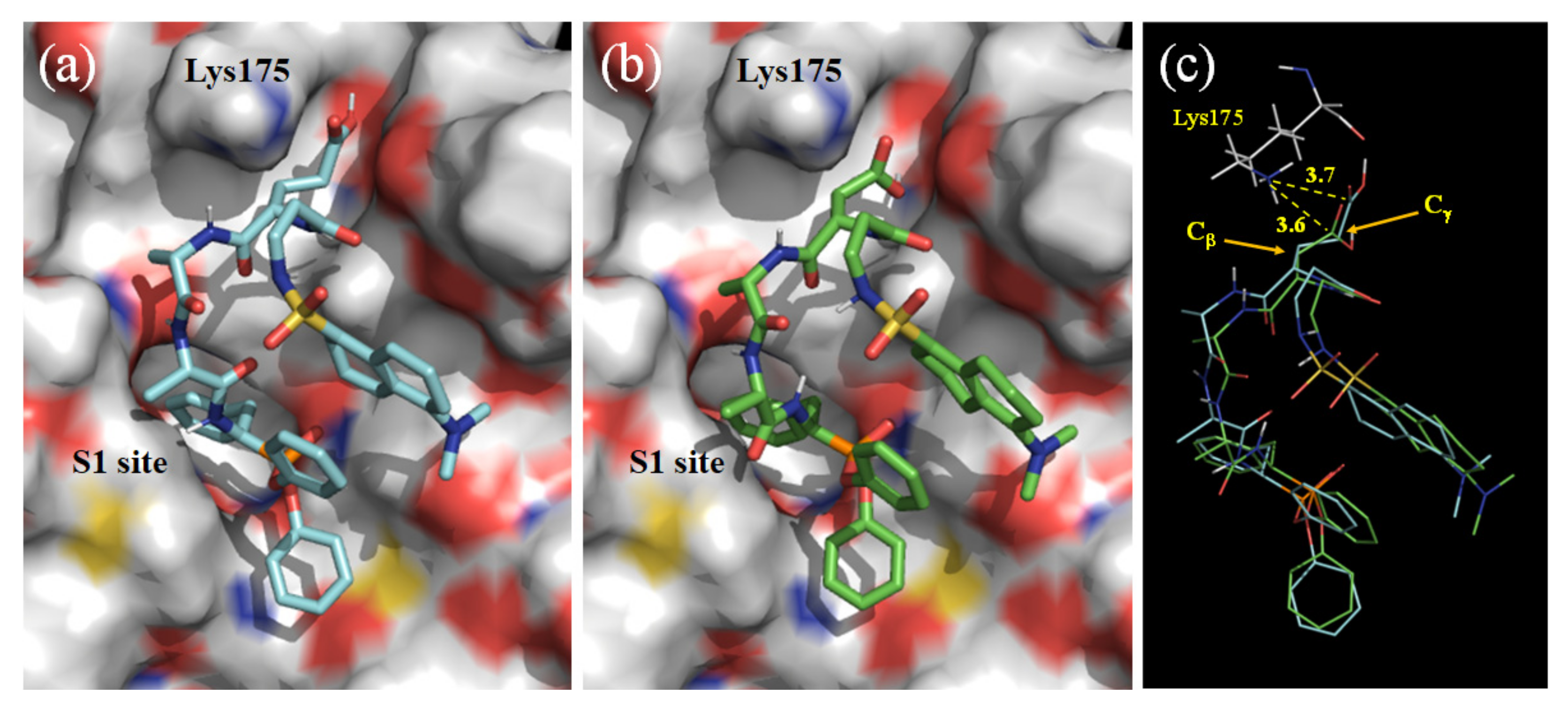

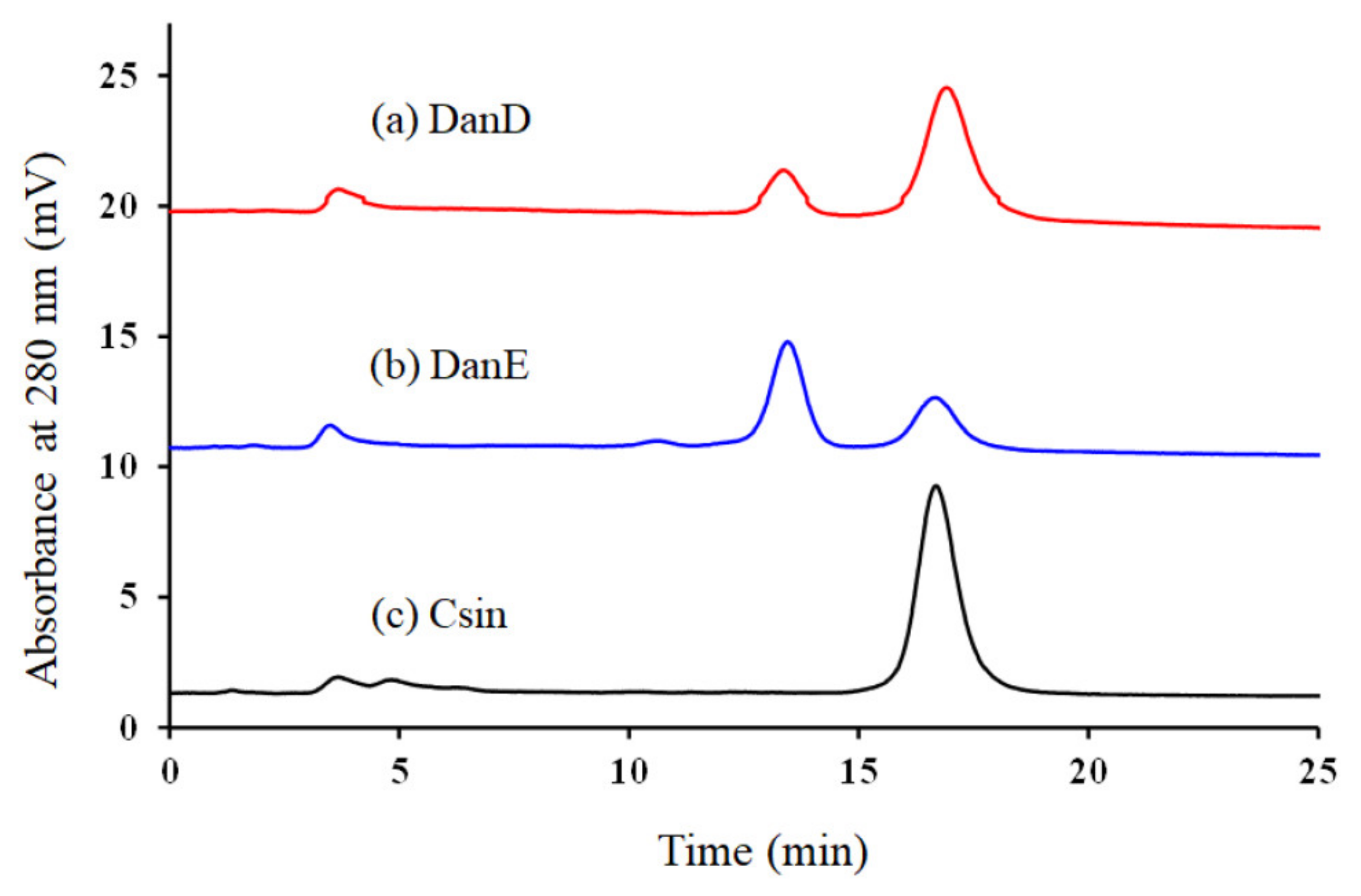

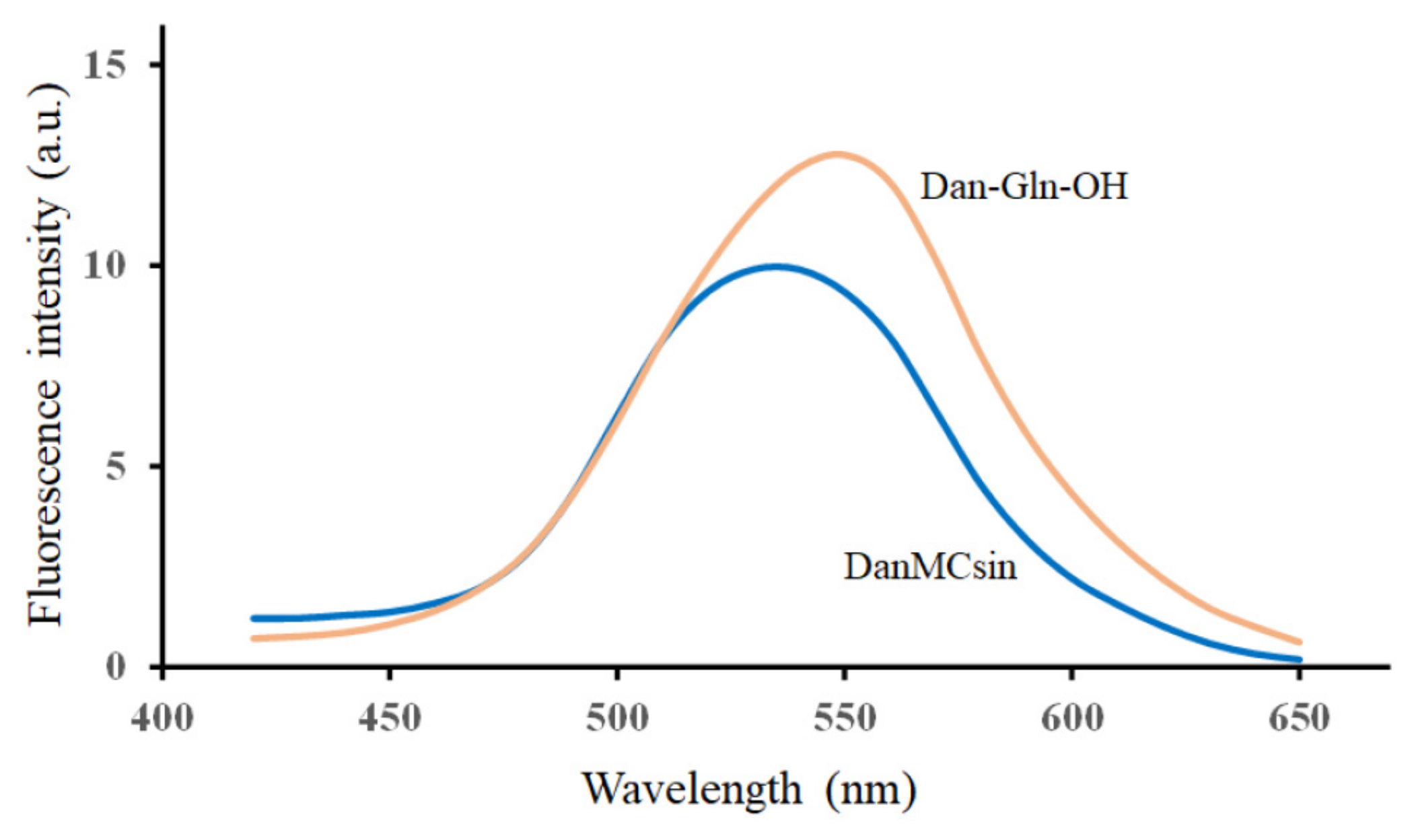
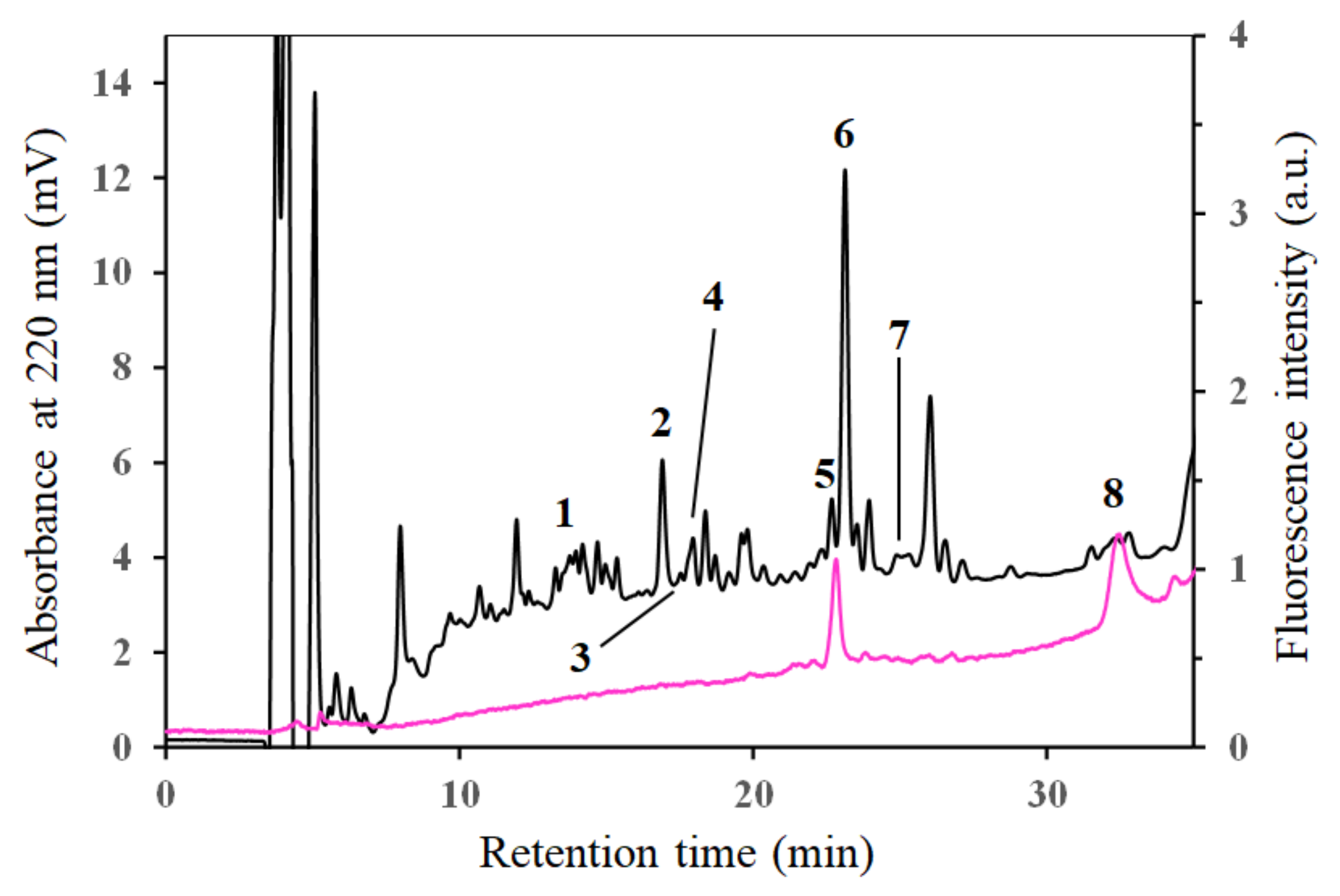
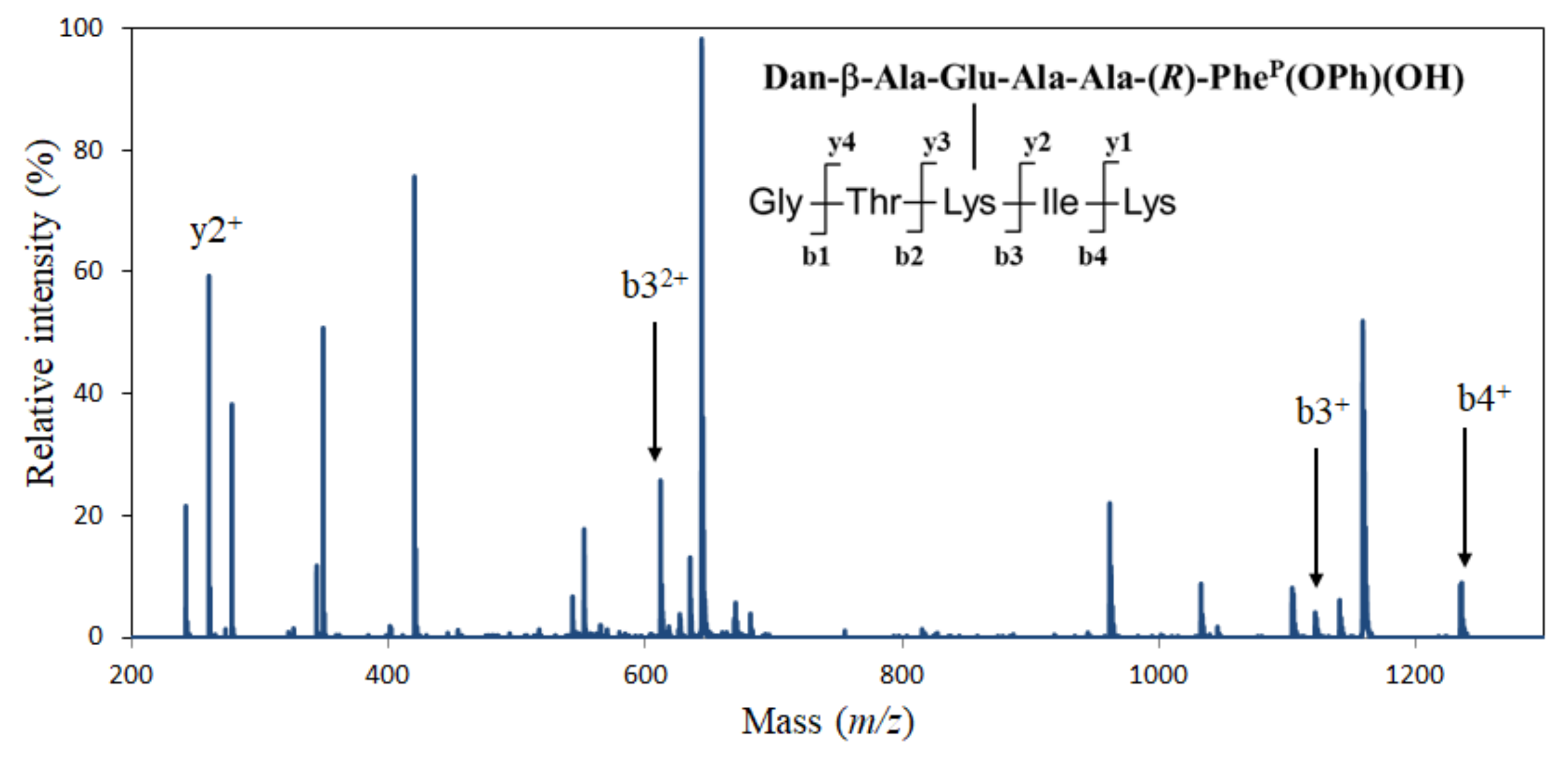

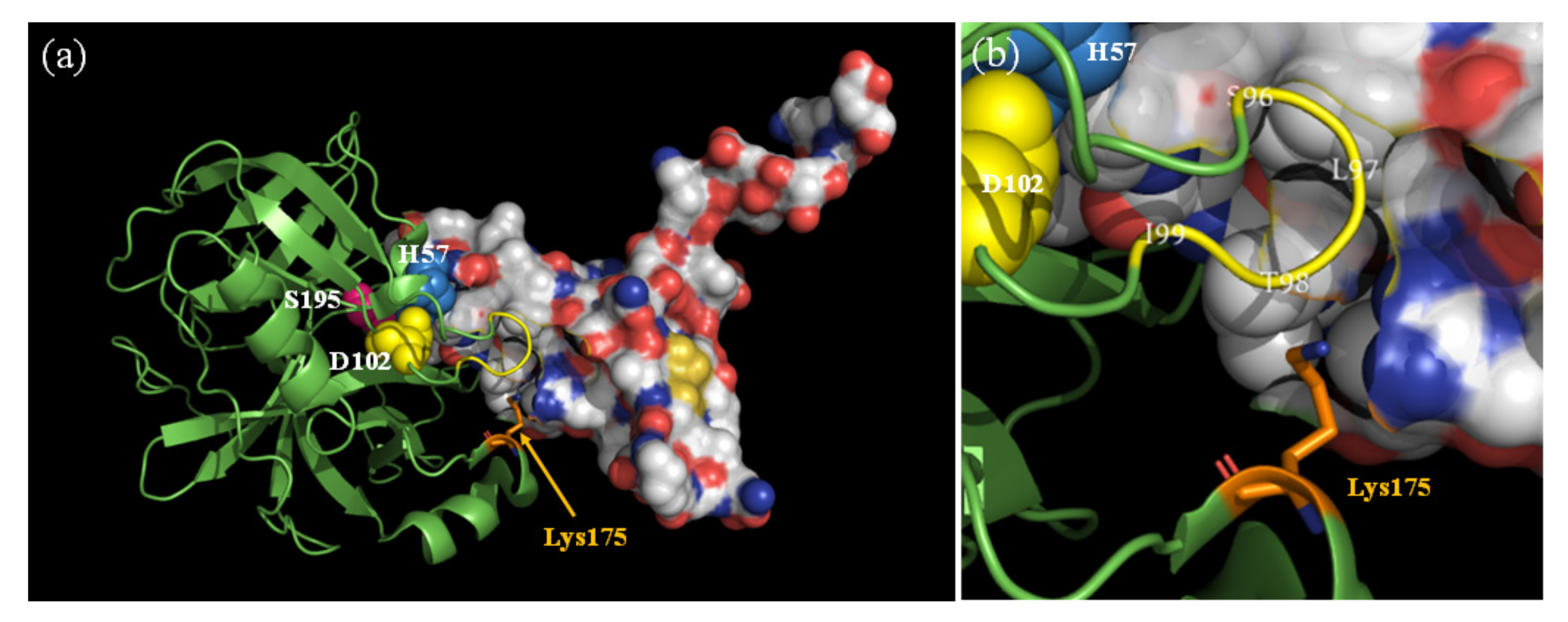
| Enzyme | Km (mM) | kcat (s−1) | kcat/Km (s−1M−1) |
|---|---|---|---|
| Csin 1 | 0.26 ± 0.02 | 49 ± 4.5 | 190,000 |
| DanMCsin 1 | 0.95 ± 0.05 | 1.5 ± 0.32 | 1600 |
Disclaimer/Publisher’s Note: The statements, opinions and data contained in all publications are solely those of the individual author(s) and contributor(s) and not of MDPI and/or the editor(s). MDPI and/or the editor(s) disclaim responsibility for any injury to people or property resulting from any ideas, methods, instructions or products referred to in the content. |
© 2023 by the authors. Licensee MDPI, Basel, Switzerland. This article is an open access article distributed under the terms and conditions of the Creative Commons Attribution (CC BY) license (https://creativecommons.org/licenses/by/4.0/).
Share and Cite
Ono, S.; Koga, M.; Arimura, Y.; Hatakeyama, T.; Kobayashi, M.; Sagara, J.-i.; Nakai, T.; Horino, Y.; Kuroda, H.; Oyama, H.; et al. Site-Selective Incorporation of a Functional Group into Lys175 in the Vicinity of the Active Site of Chymotrypsin by Using Peptidyl α-Aminoalkylphosphonate Diphenyl Ester-Derivatives. Molecules 2023, 28, 3150. https://doi.org/10.3390/molecules28073150
Ono S, Koga M, Arimura Y, Hatakeyama T, Kobayashi M, Sagara J-i, Nakai T, Horino Y, Kuroda H, Oyama H, et al. Site-Selective Incorporation of a Functional Group into Lys175 in the Vicinity of the Active Site of Chymotrypsin by Using Peptidyl α-Aminoalkylphosphonate Diphenyl Ester-Derivatives. Molecules. 2023; 28(7):3150. https://doi.org/10.3390/molecules28073150
Chicago/Turabian StyleOno, Shin, Masato Koga, Yuya Arimura, Takahiro Hatakeyama, Mai Kobayashi, Jun-ichi Sagara, Takahiko Nakai, Yoshikazu Horino, Hirofumi Kuroda, Hiroshi Oyama, and et al. 2023. "Site-Selective Incorporation of a Functional Group into Lys175 in the Vicinity of the Active Site of Chymotrypsin by Using Peptidyl α-Aminoalkylphosphonate Diphenyl Ester-Derivatives" Molecules 28, no. 7: 3150. https://doi.org/10.3390/molecules28073150
APA StyleOno, S., Koga, M., Arimura, Y., Hatakeyama, T., Kobayashi, M., Sagara, J.-i., Nakai, T., Horino, Y., Kuroda, H., Oyama, H., & Arima, K. (2023). Site-Selective Incorporation of a Functional Group into Lys175 in the Vicinity of the Active Site of Chymotrypsin by Using Peptidyl α-Aminoalkylphosphonate Diphenyl Ester-Derivatives. Molecules, 28(7), 3150. https://doi.org/10.3390/molecules28073150







